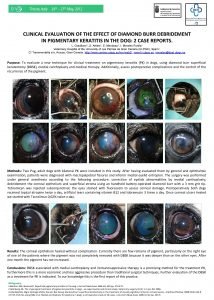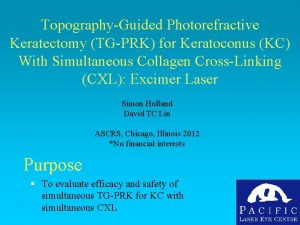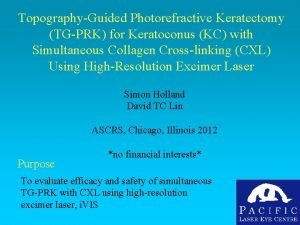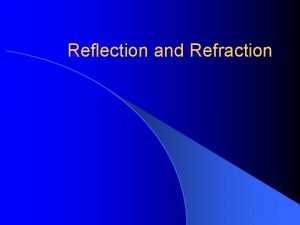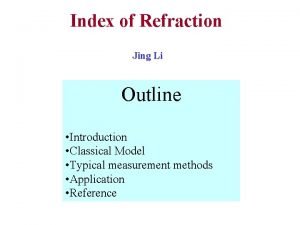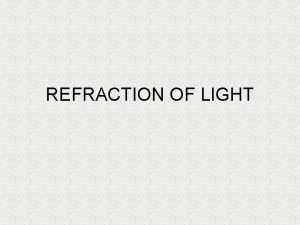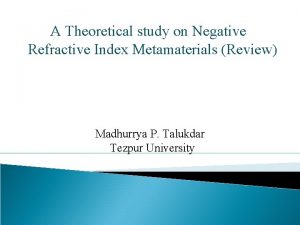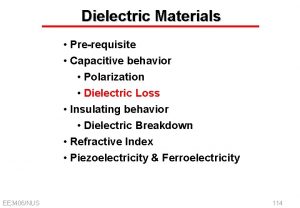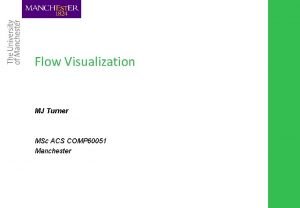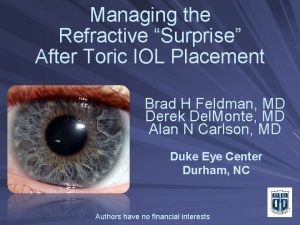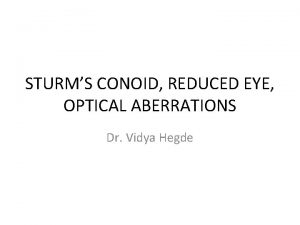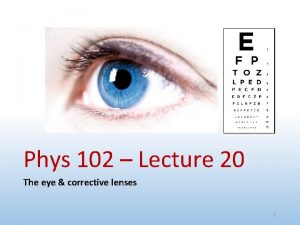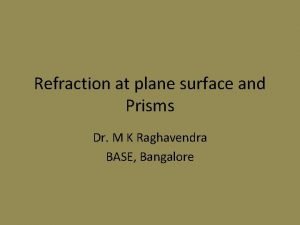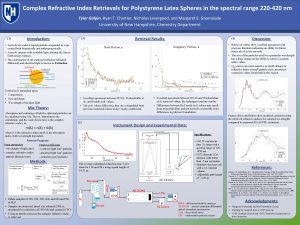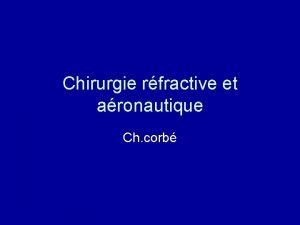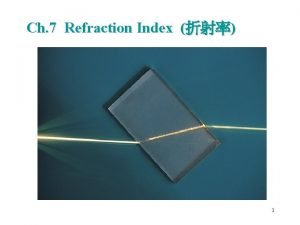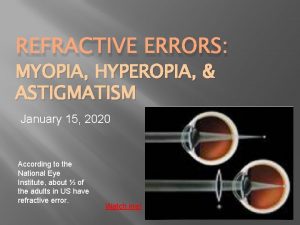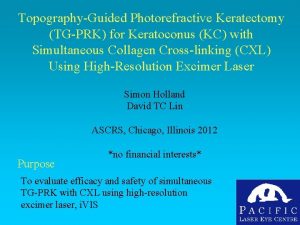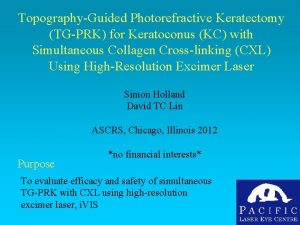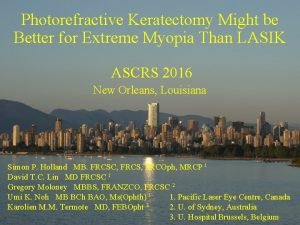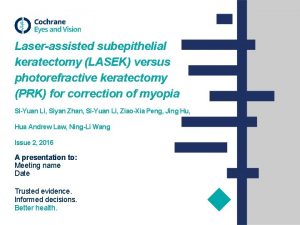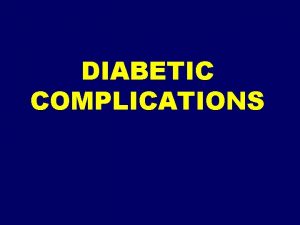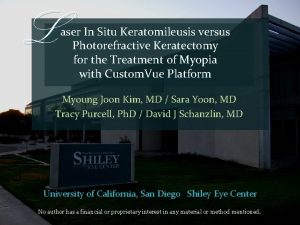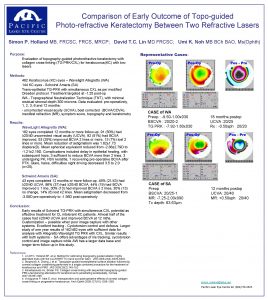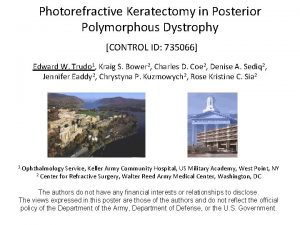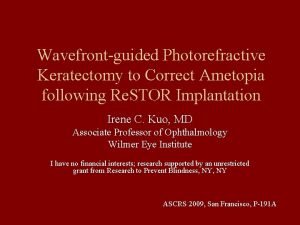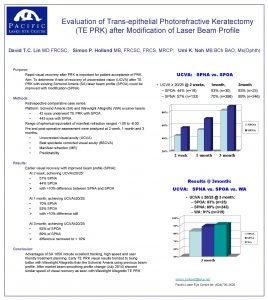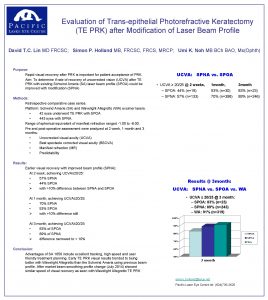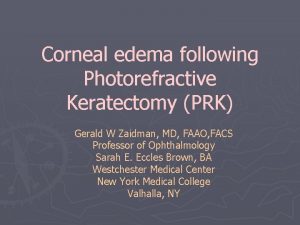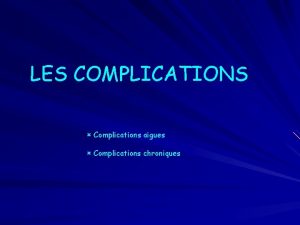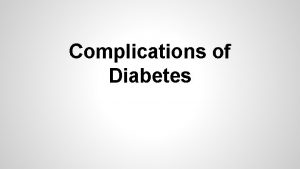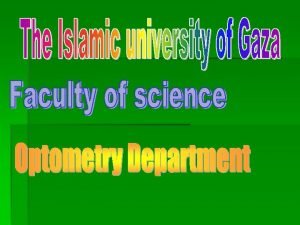Topographicallyguided photorefractive keratectomy TGPRK for complications of refractive


















- Slides: 18

Topographically-guided photo-refractive keratectomy (TG-PRK) for complications of refractive surgery David TC Lin, MD, FRCSC Simon Holland, MD, FRCSC, FRCS(Eng), MRCP, FRC Oph Pacific Laser Eye Centre UBC Dept of Ophthalmology ASCRS, San Diego 2011 No financial interests

Aim § Management of complicated laser refractive surgery challenging § Patients often intolerant or reluctant to use specialty contact lenses § Surgical options - limited as often unable to capture wavefront analysis if severely aberrated cornea § Evaluate topographically guided photo-refractive keratectomy (TG PRK) for symptomatic patients with decentered ablations (DA) and radial keratotomy (RK)

Methods § Custom neutralizing technique (TNT) for aberrated corneas with decentered ablation (DA) zones after laser refractive surgery and radial keratotomy (RK) § Allegretto Wavelight topographically-guided (TG) laser § Retrospective case series, 94 eyes DA and 49 eyes with irregular astigmatism following RK § Previous LASIK or PRK § LASIK Flap lift; PRK Trans-epithelial, § PTK with mitomycin C

Topographical Neutralisation Treatment Method of compensating for induced refraction change by surface regularization 1. Plano TG: i. e. hyperopic effect in increasing optical zone after RK 2. Correction of astigmatism induced by plano TG 3. Correction of sphere induced by 1 and 2 4. Manifest refraction added = 5. final treatment

Methods : TG PRK for DA , RK § Patient evaluation: - symptom score - blurred vision, doubling , glare , haloes, starbursts - pre and post UVA, BSCVA, refraction, topography, change in centration relative to pupil center, predictability, safety

TG PRK for DA 14 months LASIK UCVA : 20/30 Pre-op: +0. 75 -0. 50 x 117 20/20 - 3 months post-op UCVA : 20/20 RX: +0. 25 20/20


TG PRK for RK 20 years RK, LASIK BSCVA: 20/80 Pre-op: +4. 75 -3. 25 x 105 6 months post-op UCVA: 20/60 Rx: -1. 00 20/40


TG PRK for RK 20 years RK, LASIK 6 months post-op UCVA: 20/50 UCVA: 20/200 Pre-op: +1. 50 -1. 75 x 150 20/25 Rx: -1. 75 20/25


TG PRK for RK 20 years RK, LASIK UCVA: 20/100 Pre-op: +3. 75 -1. 50 x 172 20/25 4 months post-op UCVA: 20/20 Rx: +0. 75 20/20


Summary of Results Decentered Ablations § UCVA >= 20/40 77%. >= 20/25 65% § 24% gained ≥ 1 lines, 71% no change, No loss >2 line § Mean centration: from pupil center improved from 0. 92 mm to 0. 30 mm (p<0. 01) § All had improved astigmatism, 1. 25 D-6. 75 D § All symptomatic prior to surgery , 19% still had symptoms following, rated >3 on 4 point scale as moderate/severe

Summary of Results: RK § UVA >=20/40 62% >= 20/25 18% § Lost and gain >= 2 lines – 7% § Symptoms - improved in 72%.

Discussion § TG laser treatment for DA more predictable , better UCVA and less loss of lines than when performed for irregular astigmatism after RK § Tendency to overcorrect post-RK due to hyperopic effect of TG –expect to regress § Persisting diurnal fluctuation § Alleviated more severe symptoms in most patients in both groups

Conclusion: TG laser for aberrated corneas after previous refractive surgery § Valuable option for highly symptomatic patients with Decenterd Ablations and after RK § Refractive predictability is better with neutralization (Custom TNT) but still needs improvement

Palmyra, Syria
 Diamond burr keratectomy dog
Diamond burr keratectomy dog Tg prk
Tg prk Tg-prk
Tg-prk Perspex refractive index
Perspex refractive index Complex refractive index
Complex refractive index Refractive amblyopia
Refractive amblyopia How to calculate angle of refraction
How to calculate angle of refraction Negative refractive index
Negative refractive index Permittivity refractive index relation
Permittivity refractive index relation Msc acs
Msc acs Refractive surprise
Refractive surprise Donders reduced eye
Donders reduced eye Refractive power formula
Refractive power formula The refractive indices of crown glass prism for c d f
The refractive indices of crown glass prism for c d f Becke line
Becke line Index of refraction of polystyrene
Index of refraction of polystyrene Classement chirurgie réfractive
Classement chirurgie réfractive Refractive index of substances
Refractive index of substances Refractive error diagram
Refractive error diagram
